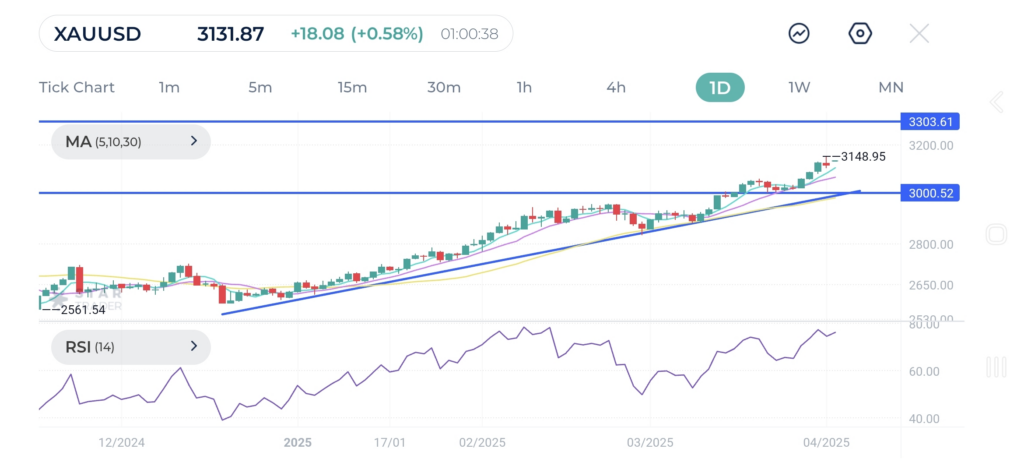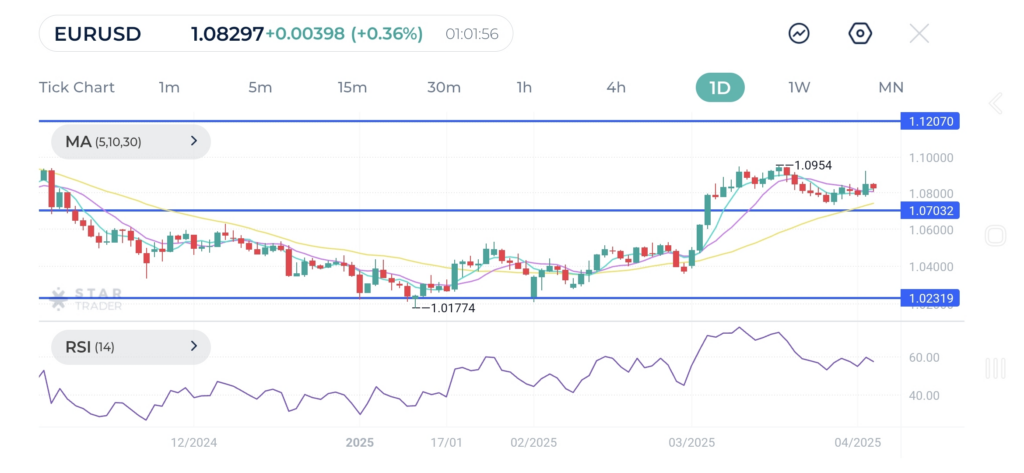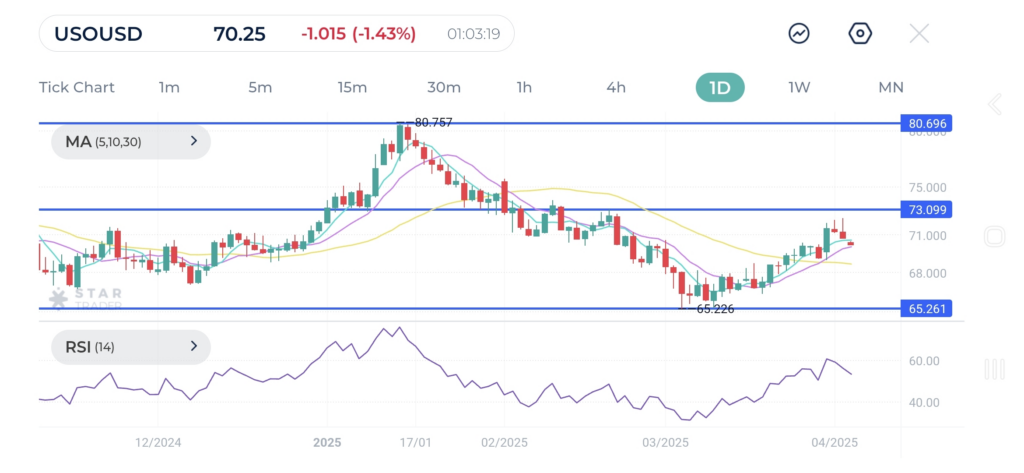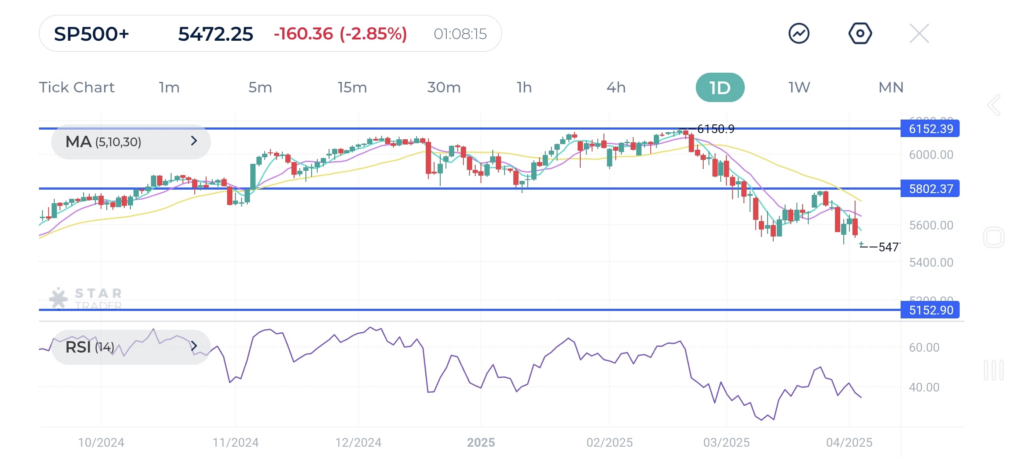Monthly Forex & Market Outlook – Trade War & Market Forecasts

Key Factors
- Central Bank Policies
- Fed’s stance on inflation and growth, particularly the likelihood of a June rate cut.
- ECB’s signals on further rate cuts, with policymakers citing slowing wage growth and easing inflation.
- Trade War Escalation
- Escalation of U.S. tariffs with a two-step tariff policy, imposing a 10% baseline tariff on all imports.
- Likelihood of joint retaliatory measures that could disrupt global supply chains.
- Geopolitical Risks
- Russia-Ukraine ceasefire talks and impact on global energy supply.
- OPEC+ production adjustments, including deeper cuts for seven member nations and a modest April output hike.
- Broader Economic Concerns
- Potential impact of higher import costs on corporate margins and consumer prices.
- Slow economic growth as a risk factor for valuations and earnings.
Gold Outlook
Bullion continues to hold onto its all-time high amid geopolitical tensions and a reduction in global borrowing costs. The Federal Reserve held its benchmark policy rate steady in the 4.25%–4.50% range, while policymakers revised their inflation projections higher for the year and lowered growth expectations in response to tariff measures introduced under the Trump administration. Chair Jerome Powell cautioned that inflation progress may be slower than anticipated, partly due to the impact of these tariffs.
President Donald Trump escalated trade tensions with the announcement of sweeping global reciprocal tariffs, declaring that the U.S. would implement a 10% baseline tariff on all imports, with even steeper duties targeting key trading partners. The move significantly intensifies the trade war that reignited upon his return to the White House, raising concerns over inflationary pressures, supply chain disruptions, and potential retaliatory measures from affected nations. Investors responded by shifting toward safe-haven assets, with gold remaining near record levels as market uncertainty deepened. The precious metal has found further support from shifting interest rate expectations, as Fed funds futures now indicate a 70% probability of a rate cut at the June meeting, up from 57% prior to the Fed’s decision. Lower rates enhance gold’s appeal, as it carries no yield.
The downside risk would come from a stronger-than-expected economic recovery, easing geopolitical tensions, or a more hawkish Fed which could dampen demand for the precious metal, potentially capping further gains or triggering a pullback. Despite these potential headwinds, gold’s rally remains underpinned by persistent safe-haven inflows and central bank accumulation, reflecting a broader trend of de-dollarization among emerging market economies. If inflation remains elevated and interest rates decline as market expected, gold’s upward trajectory could continue, reinforcing its role as a hedge against macroeconomic instability.
Market participants will closely watch upcoming economic data releases, notably the March CPI and nonfarm payrolls, Fed signals, and geopolitical developments, which could dictate gold’s direction in April.
Technical Forecast

Gold has advanced over 20% since January, and there is no visible sign of weakness yet. The price action suggests rather strong momentum after a brief consolidation as shown by a steep upward trend line. Limited declines are signs of profit-taking and have so far only attracted more buying interests. The bottom of the recent pullback coincides with the psychological level of $3,000 and the 30-day moving average, making it a critical support zone in case of a pause. This would offer traders another buying opportunity to align with the broader bullish trend. Past $3,100, $3,300 is another milestone to register.
EUR/USD Outlook
Expectations for an April rate cut by the European Central Bank (ECB) are gaining traction after a number of policymakers showed growing confidence in the move. Even though the central bank has so far offered little forward guidance following its latest rate reduction in March, citing high levels of uncertainty.
Both Bank of Greece Governor Yannis Stournaras and ECB board member Piero Cipollone signaled support for another rate cut, even as some officials on the Governing Council remain cautious. “The case for further easing is strengthening,” Cipollone stated, reinforcing market expectations that the ECB may act again soon. In an interview with Econostream, Stournaras noted that February inflation had eased to 2.3%, aligning with the ECB’s projected path. He highlighted the importance of further reductions in borrowing costs to support the economy, and pointed to slowing wage growth in Q4 2024, easing service-sector inflation, and a decline in core inflation as key factors strengthening the case for policy easing.
Since June of last year, the ECB has cut rates six times, aiming to balance inflation risks with economic growth concerns. If the United States were to impose tariffs on European exports, the resulting decline in demand could exacerbate disinflationary pressures across the eurozone. Weaker export activity would weigh on economic growth, potentially reinforcing the ECB case for further monetary easing.
Market participants will be watching closely for any shifts in tone from policymakers in the coming weeks as speculation around the timing of the next move intensifies. Markets are now pricing in a higher probability of a rate cut at the April meeting, with investors closely monitoring upcoming economic data and central bank commentary for confirmation of a dovish pivot.
Technical Forecast

EUR/USD is pulling back after testing major resistance at 1.0940, though the bullish bias remains intact as the price holds above the 30-SMA (1.0700). The pair gained strength after a consolidation phase, breaking above 1.0600 and subsequently tentatively piercing 1.0950, forming a series of higher highs and higher lows. Currently, the price is retracing to test support at the 30-SMA, suggesting a temporary pause in bullish control. If the moving average holds, a rebound could see EUR/USD retesting 1.0950, with a breakout confirming further upside toward the 1.1200 resistance. A failure to hold above said level, however, could signal deeper corrective pressure before the next bullish leg.
WTI Outlook
Oil prices are trying to stay stable as traders weighed the prospects of ceasefire talks between Russia and Ukraine, which could lead to a resurgence of Russian crude supply in global markets. Lingering weakness reflected expectations of progress in peace negotiations and a potential easing of U.S. sanctions on Russian oil. Apart from the geopolitical chessboard, investors remain cautious, awaiting further clarity on OPEC+ production trends beyond April.
OPEC+ recently unveiled a new schedule requiring seven member nations to implement deeper output cuts to offset previous overproduction, effectively outweighing the planned supply increases set to begin next month. Since 2022, the group has collectively reduced production by 5.85 million barrels per day—roughly 5.7% of global supply—in a bid to stabilize the market. It confirmed on March 3 that eight members would move ahead with a modest monthly output hike of 138,000 barrels per day from April, citing improving market fundamentals.
Meanwhile, traders are also monitoring the fallout from fresh U.S. sanctions targeting Iranian oil shipments. Tensions between Washington and Tehran have remained elevated since President Trump reinstated stringent sanctions aimed at crippling Iran’s economy. The U.S. perceives Iran’s nuclear ambitions as a significant security threat, while Tehran maintains that its nuclear program is for peaceful purposes. This ongoing standoff has previously sparked military escalations and heightened regional instability. A return to diplomatic negotiations could potentially ease these tensions and help avert further conflict in the Middle East. However, Iran remains deeply skeptical of U.S. intentions, especially after Trump’s abrupt withdrawal from the 2015 nuclear deal, which had initially aimed to curb Iran’s nuclear development in exchange for sanctions relief.
While leaving the door open for future talks, the Trump administration has reasserted its “maximum pressure” strategy, focusing on severely limiting Iran’s oil exports. Since regaining office, the administration has enacted four rounds of sanctions targeting Iran’s energy sector, further complicating any potential diplomatic resolution. While the latest measures have driven up shipping costs and could temporarily curb Iranian crude flows to China, market participants expect buyers to find alternative routes to maintain at least some level of supply. Price-wise, the commodity may find a little support as long as both Russian and Iranian outputs are out of the official channels.
Technical Forecast

On the daily chart, the price remains in a bearish zone below the $80.70 level. After starting a fresh decline below the $69.00 support, the price dipped to $65.20. From there, a recovery wave took place, pushing the price back towards $70.00. The price is currently consolidating above May 2023 and September 2024 swing lows as buyers struggle to establish a base before they could push back. If the price continues to recover, and manages to break above the first resistance level at $73.00, the bulls may have another chance to test $80.70. On the downside, if the price resumes the bearish move, it could revisit the $65.20 support where a breach could lead to further declines, with potential targets at $60.00.
S&P 500 Outlook
U.S. stocks have been on a roller-coaster, with the S&P 500 struggling to contain its losses, as investors digest President Donald Trump’s tariff crusade. Rumours that he would scale back the scope of planned tariffs set to take effect on April 2 were followed by a two-step tariff strategy, implementing his long-anticipated “Liberation Day” trade policy. Under the new plan, a baseline 10% tariff on all imports will take effect on April 5, marking a broad escalation in U.S. trade protectionism. Additional levies targeting what the administration deems the “worst offenders” will follow on April 9, intensifying pressure on key trading partners. The move signals a sharp shift toward economic nationalism, with Trump framing the tariffs as a necessary step to reduce trade imbalances and bolster domestic industries. However, markets reacted with volatility, as investors weighed the potential fallout. With global trade partners expected to respond, the coming weeks will be critical in determining whether Trump’s aggressive stance leads to renewed negotiations or escalates into a full-scale trade war.
Trump may use tariffs as negotiation chips. Should this happen it would provide relief to investors, who had feared that sweeping tariffs could accelerate inflation and strain economic growth. The resulting price increases on imported goods would have added inflationary pressure to the economy. Higher import costs would likely have been passed down to consumers and businesses, leading to a rise in overall price levels. In such a scenario, the Federal Reserve, which closely monitors inflation dynamics, may have been forced to shift its policy stance. Instead of moving toward rate cuts, as markets have increasingly priced in, the Fed could have been compelled to maintain or even raise interest rates to curb inflationary pressures.
Keeping interest rates steady instead of lower, in turn, means tight financial conditions, and high enough borrowing costs for businesses and consumers to potentially dampen economic activity. Such policy would be a growing concern among market participants, weighing on corporate profits and equity valuations. Markets will now closely watch for further policy details, as uncertainty around trade remains a key risk factor for equities.
Technical Forecast

The S&P 500 has broken below the lower boundary of its medium-to-long-term rising trend channel from October 2023, suggesting an initial slowdown in upward momentum or the potential for a more sideways market development. The index has struggled to recover above 5,800 following the breakdown from a double top formation around 6,150. The rejection at that supply area triggered renewed selling pressure, suggesting the possibility of further downside movement as medium-term bulls could continue to take profit. Overall, the technical outlook remains negative in the short-term, with further weakness towards 5,150 possible unless key resistance levels are decisively breached.
Key Dates
- Friday, April 4
Nonfarm Payrolls - Wednesday, April 9
RBNZ Interest Rate Decision
FOMC Minutes - Thursday, April 10
US Consumer Price Index - Tuesday, April 15
BoC Consumer Price Index Core - Wednesday, April 16
UK Consumer Price Index
BoC Interest Rate Decision - Thursday, April 17
ECB Monetary Policy Statement
Wednesday, April 30
US Gross Domestic Product







